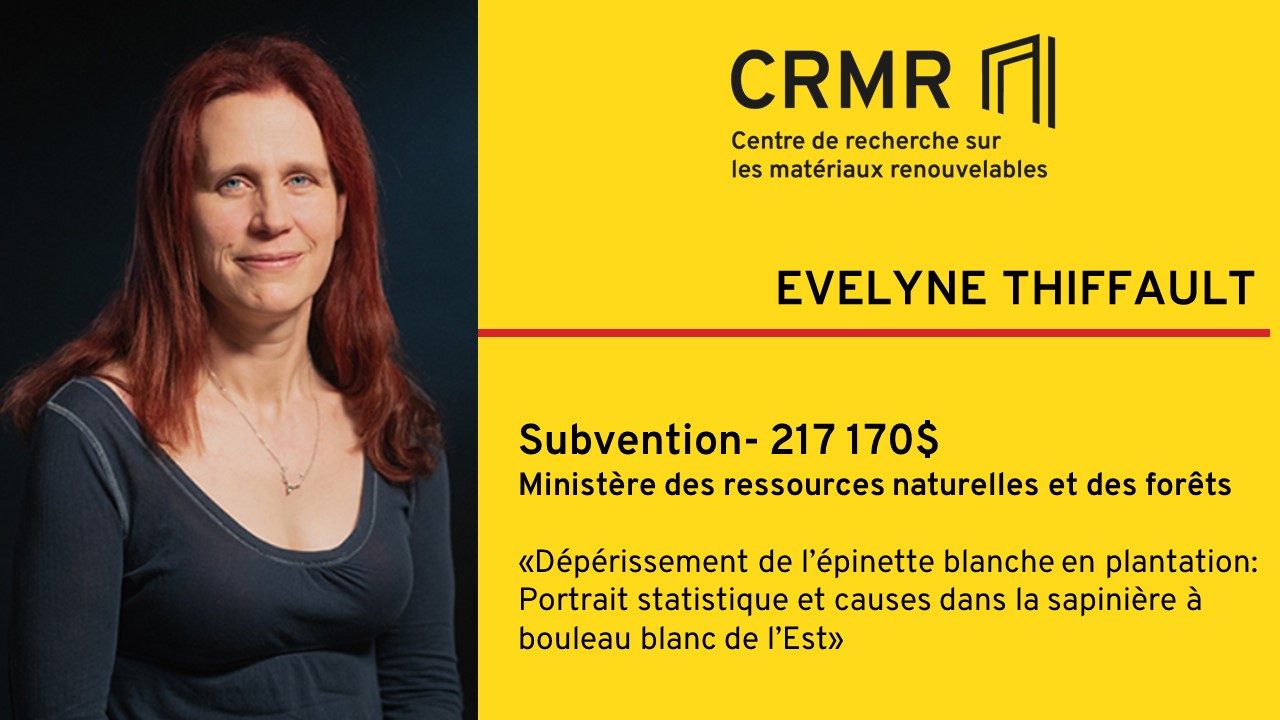Congratulations to Evelyne Thiffault, recipient of a grant from the Ministry of Natural Resources and Forestry!
Congratulations to Evelyne Thiffault, a professor in the Faculty of Forestry, Geography and Geomatics (FFGG), Laval University, and member of the Renewable Materials Research Centre (CRMR), who has been awarded a grant from the Ministry of Natural Resources and Forestry (MRNF), as principal investigator for research in sustainable forest management on « White spruce dieback in plantations: Statistical portrait and causes in the eastern white birch fir stand ».
This research project will benefit from $217,170 in funding over three years from the MRNF, and will benefit from the expertise of a multidisciplinary team and contribute to the training of two master’s students.

Research team:
The research team consists of Evelyne Thiffault (principal applicant, Laval University), Mathilde Routhier (Ministry of Natural Resources and Forestry), Nelson Thiffault (Natural Resources Canada’s Wood Fibre Centre and scientific co-director of the Reboisement Ligniculture Québec Network), David Paré (Natural Resources Canada’s Forest Service) and Rock Ouimet ( Direction of Forest Research).
Project objectives
The aim of this project is to analyse the decline of white spruce used for reforestation in the eastern white birch fir stand, in a context where this species is a key component of forest management strategies in this area. More specifically, this research aims to analyse the links between edaphic, silvicultural, climatic and nutritional conditions and the decline of white spruce used for reforestation.
The specific objectives are as follows, each corresponding to a master’s project (MSc1 and MSc2):
- To provide a statistical portrait, at the landscape level, of the occurrence (presence/absence) and intensity (proportion of stems affected and degree of decline) of white spruce decline as manifested by foliage chlorosis in reforested sites.
- To study, at the site level, the effect of climatic and nutritional conditions on the occurrence and intensity of white spruce dieback as manifested by foliage chlorosis in reforested sites.
Project benefits
In addition to training highly qualified personnel, the research underway will not only help to understand the statistical picture and the causes of the decline of this species, but also the management and preservation of forest resources. This could include specific silvicultural practices or management strategies to promote the resilience of white spruce. The results of this project are also likely to have direct implications for forest management decisions, enabling authorities and practitioners to take more informed measures to preserve and optimise forest resources.
On the environmental front, the project will help reduce uncertainties associated with forest management strategies by providing information on the use limits and tolerance thresholds of white spruce for reforestation. This could help to better adapt forestry practices to changing conditions. The results will also provide food for thought on optimal silvicultural scenarios for increasing carbon sequestration in forests and wood products. This is all part of the fight against climate change.
White spruce is a key species in current management strategies, and its wood is highly sought-after by processing plants. Products derived from white spruce have a long lifespan, underscoring its economic importance.
Congratulations to Evelyne and her team for their commitment to this research, which is crucial to the sustainability of forest ecosystems. Stay tuned for publications from this brilliant project!

